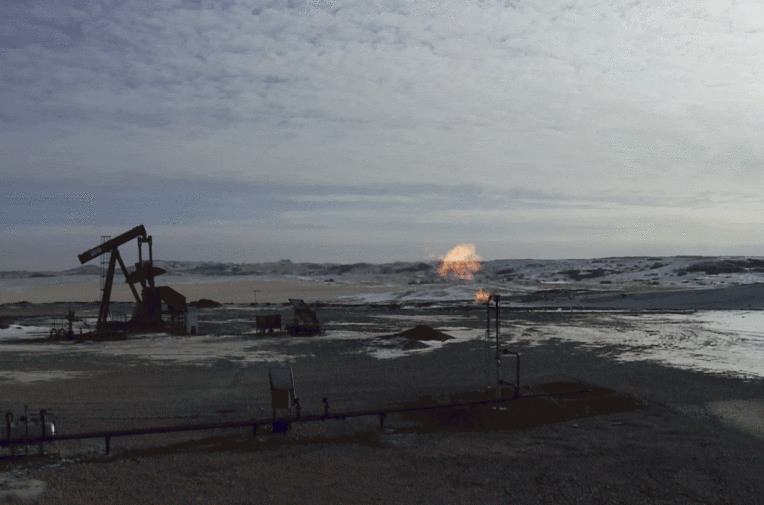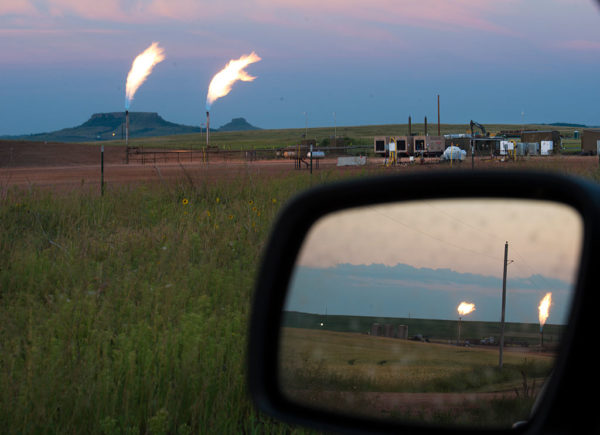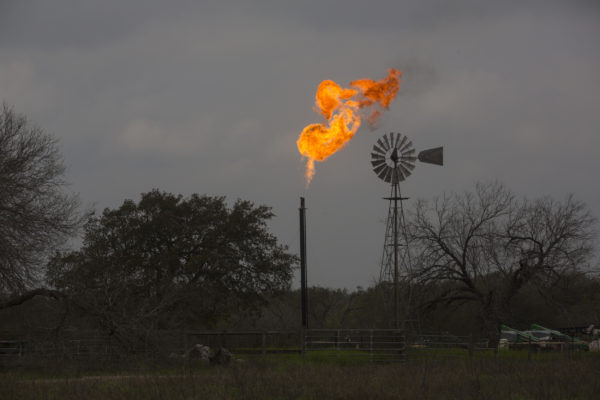
Oil companies are disposing of billions of cubic feet of natural gas into the atmosphere. Image: Unearthed / Counter
Exxon and BP among worst for flaring in US oil fields despite green pledges
An analysis of official industry data by Unearthed reveals the companies most responsible for the massive emissions created by burning unwanted gas
Exxon and BP among worst for flaring in US oil fields despite green pledges
An analysis of official industry data by Unearthed reveals the companies most responsible for the massive emissions created by burning unwanted gas
Oil companies are disposing of billions of cubic feet of natural gas into the atmosphere. Image: Unearthed / Counter
ExxonMobil and BP are among the worst culprits for wastefully burning off natural gas in the United States’ top oil fields, despite presenting themselves as leaders in tackling the problem, Unearthed can reveal.
The oil giants have both committed to drastically rein in flaring – where gas is burned with no economic benefit – as a key part of their response to the climate crisis.
But a major new investigation by Unearthed, based on official industry data, has found that they are among the worst performers when it comes to minimising emissions from their operations in one or more of the United States’ “Big Three” oil fields.
Independent fracking firms, Marathon Oil, Whiting Petroleum and Hess Corporation are also disposing of unprecedented volumes of natural gas, either by releasing it directly into the atmosphere or burning it off – practices called venting and flaring.
In recent years a surge in oil production has lit up the skies across Texas, New Mexico and North Dakota as companies burn off billions of cubic feet of natural gas.
Industry claims to support methane regulation look like greenwashing
Now, for the first time, Unearthed can reveal the scale of this waste and the oil companies most culpable for the enormous greenhouse gas emissions created by venting and flaring in America’s biggest oil fields.
Together, the Eagle Ford basin in Texas; the Permian basin in Texas and New Mexico and the Bakken formation in North Dakota, accounted for 57% of US oil production in 2018.
But they also harbour billions of cubic feet of natural gas and oil companies often find it easier and cheaper to dispose of it into the atmosphere than capture and transport it to where it can be sold and used to generate energy.
Unearthed can reveal that over a period of just 12 months, companies operating in these oil fields have vented or flared 369 billion cubic feet of natural gas, roughly equivalent to the annual emissions of 10 coal-fired power stations or 8 million cars.
This is particularly problematic because the Permian is set to be the focal point of a boom in global oil production over the next decade.
The investigation, based on official industry data provided by Rystad Energy, also found:
- ExxonMobil has vented or flared more gas than any other company operating in the three oil fields since 2011, despite not being the largest gas producer
- Permian drilling operations acquired by BP in a $10.5 billion deal last year already ranked among the worst in the basin for the proportion of gas vented or flared, but performance has declined further under the British oil major
- Fracking giant Marathon Oil vented or flared more gas than any other company across the “Big Three” in the 12 months up to the end of March 2019, including 52% of the gas it produced in the Bakken
Responding to the investigation, Senator Sheldon Whitehouse [D-RI] told Unearthed that the findings appear to contradict the claims of the US oil industry’s most powerful lobby group: “These are troubling findings, which belie the American Petroleum Institute’s seven-figure ad campaign claiming the industry is working to reduce carbon pollution.”
“Industry claims to support methane regulation look like greenwashing; old bad habits from an industry that spent decades trying to deceive the public about climate change,” he continued.
Even though natural gas is big business in the United States, low prices have led companies in the “Big Three” oil basins to dispose of billions of cubic feet of it into the atmosphere.
This is because the companies are targeting the enormous reserves of oil rather than gas, which is present in smaller volumes. And while oil can be loaded onto trucks and driven to a refinery, gas can only be transported via pipeline.
The costs of capturing gas; purchasing access to pipelines or building new ones; and then paying state taxes on the proceeds, can often outweigh the economic benefits, leading companies to release it directly into the atmosphere (venting) or burn it off (flaring) instead. Venting is more damaging than flaring because methane is 84 times more effective at trapping heat than carbon dioxide in the first two decades following its release.
Industry leaders
As pressure on oil companies to demonstrate that they are taking climate change seriously has intensified, ExxonMobil and BP have increasingly sought to portray themselves as industry leaders in reducing emissions from their oil drilling operations.
Both companies are members of the Oil & Gas Climate Initiative (OGCI), a leading trade association, which held high profile events during the recent UN Climate Week in New York, celebrating the achievements of its members in reducing methane emissions.
Tackling venting and flaring are central to OGCI members’ joint strategy for how they will contribute to reducing global emissions in line with the Paris climate change agreement.
Flaring is an important issue we take very seriously
As a result, Exxon and BP have also made individual pledges. Last year Exxon said it would reduce its greenhouse gas emissions by cutting flaring by 25% within two years, adding to a previous commitment to eliminate routine flaring entirely by 2030.
BP has likewise committed to eliminate routine flaring and regularly publicises initiatives tackling methane emissions from its operations. Its chief executive, Bob Dudley, recently said that the level of flaring in the Permian is “not right.”
But Unearthed can reveal that both companies are failing when it comes to bringing the emissions from some of their US oil operations under control.
Since 2011, ExxonMobil has vented or flared 99 billion cubic feet of gas, more than any other company operating in the Permian, Eagle Ford and Bakken oil fields, despite the fact it was not the largest producer of gas.
In the 12 months between April 2018 and March 2019 alone, Exxon vented or flared 12 billion cubic feet of gas in the Permian, more than any other company.
And despite its commitment to reduce its overall flaring by 25% by 2020, between 2017 and 2018 Exxon’s venting and flaring in the “Big Three” oil basins actually increased by 70%, even though gas production rose by only 15%.
Artem Abramov, partner and head of shale research at Rystad Energy, told Unearthed: “In the Permian specifically, Exxon were stepping up, in terms of activity and production, very aggressively last year. We saw that a lot of these new developments were happening in more remote areas without developed infrastructure.”
He added that Exxon’s drilling program often outpaced the development of infrastructure to take the gas away: “There were some delays and then they had to flare gas for extended periods of time… two to three months wouldn’t be too rare I would say.”
An ExxonMobil spokeswoman told Unearthed: “Flaring is an important issue we take very seriously. We have made great progress in reducing flaring by working with third-party gas gathering systems, accelerating installation of gas facilities, improving facility reliability and curtailing production when appropriate. The company is in full compliance with state and federal flaring regulations and makes every effort possible to exceed those standards.”
“In the examples you cite, flaring is done for safety reasons or because the gas cannot be used due to barriers to the development of gas markets and gas infrastructure,” she continued.

Declining performance
In keeping with Exxon and most of its rivals, BP flares a relatively low percentage of the gas it produces in the Eagle Ford basin – but the same cannot be said for its operations in the Permian.
The company took ownership of BHP’s Permian operations on November 1 2018, following a $10.5 billion deal. These oil wells were already venting and flaring a higher proportion of gas than any other large producer in the basin, but since BP took over the poor performance has continued.
Between October and December 2018, the percentage of gas vented or flared was 14%, the second highest in the basin. From January to March 2019, BP flared 13.1% of its gas, the third highest in the Permian.
Since BP took over direct operation of its Permian oil wells on March 1, the proportion of gas vented or flared has increased from 12% in February to 18% in May, the most recent month for which there is reliable data.
The company declined to reveal whether it knew about the poor emissions performance of these assets before it purchased them. But the reported data, which BP would have had access to, clearly shows that BHP disposed of a higher proportion of gas than any other company in the Permian between 2011 and 2018.
When Bob Dudley was questioned about this performance earlier this year he expressed surprise, telling a June 30 earnings call: “I’m not sure the accuracy of it [sic]. Haven’t looked and fact checked it… l’d really like to go in and see those figures because they seem a touch high to me. But don’t worry, we’ll be all over it.”
In February, Unearthed revealed that BP had successfully lobbied the Trump administration to scrap a major Obama-era regulation limiting venting and flaring on public lands.
A spokesperson for BP told Unearthed: “We are committed to reducing our flaring in the Permian basin and since BPX Energy began operating our newly-acquired assets in March of this year we have started constructing centralized facilities which, combined with some of our other emissions reduction efforts, will reduce routine flaring.”
This won’t happen overnight though, and in the meantime BP is likely to continue to flare a high proportion of its gas rather than hold back production. According to Abramov: “any kind of production curtailment… reduces the value of the asset because you delay a lot of cash flow.”

Marathon Oil
Despite the key role played by oil majors, most of the companies venting and flaring the highest volumes of gas across the three oil fields are large independent fracking companies, such as Marathon Oil, which are under far less pressure from investors and civil society to reduce their emissions.
In the 12 months up to March 2019, Marathon vented or flared almost 30 billion cubic feet of gas across the three oil fields, more than any other company.
The vast majority of this (25 billion cubic feet) took place in the Bakken, where Marathon vented or flared an exceptional 52% of the gas it produced.
Abramov told Unearthed that even though Marathon is flaring a significantly higher proportion of gas than its peers, the state as a whole is flaring double the amount stipulated by the regulator. He added that this won’t necessarily result in strong action from the North Dakota Industrial Commission though: “they are probably trying to find a balance between the environmental perspective and the economic perspective because the state is quite dependent on all the tax revenues they get from the oil industry.”
Marathon Oil failed to respond to requests for comment.
Hess Corporation and Whiting Petroleum were also among the companies venting and flaring the most gas across the three basins between April 2018 and March 2019. Whiting, vented or flared 19 billion billion cubic feet of gas during this period, while Hess wasted 17 billion cubic feet.
Both companies failed to respond to multiple requests for comment.
Mark Boling, a former executive at Southwestern Energy, a large independent producer headquartered in Houston, told Unearthed: “for many oil and gas companies, if they are not required to do something, they just won’t. If it’s not making them money and there is no regulatory requirement to do it, they will justify doing nothing by citing their ‘obligation’ to maximise shareholder value. The regulatory aspects of this, in terms of just making people do what is the right thing to do, has been lacking.”
According to a recent investigation by Energy Intelligence, Texas’ oil and gas regulator has never denied an oil company’s application for a flaring permit.
Illustrating the depth of the problem, one producer in the Eagle Ford basin, Exco Resources, vented or flared 63% of the gas it produced in the 12 months up to March 2019, despite its wells being connected to a gas pipeline. According to reports, Exco simply didn’t want to pay the pipeline company to transport the gas. When contacted by Unearthed, a spokesperson for Exco said it had “no comment”.
Unearthed obtained reported industry data from Rystad Energy and looked at operator production and venting/flaring levels from 2011 through to the present.
We adopted two widely accepted methods for looking at venting and flaring performance. Firstly, the absolute volume of gas wasted; second, the proportion of gas that a company produces that is wasted.
Based on this analysis we compiled league tables for each of the major basins for the period 2011-2018 and for the 12 months up to March 2019 – both in absolute and percentage terms. We also did this for all three basins combined.
The data revealed particular concerns for BP and Exxon in the Permian basin and, in the case of Exxon, the Bakken field. Neither oil major flared a significant percentage of gas in the Eagle Ford basin, where overall flaring and venting numbers are much lower.
We estimated the overall greenhouse gas emissions resulted from the 369 billion cubic feet of gas that was wasted across the three basins based on an estimate that 92% of it was flared and 8% vented. This is based on Rystad Energy data for the New Mexico portion of the Permian, where the state regulator requires the breakdown between venting and flaring to be reported by oil companies.
Rystad said that last year an average of 8% of waste gas was vented across the basin and there is no reason to think this figure is any different across the Texas portion of the Permian basin. Given the lack of any venting data for North Dakota, we applied the 8% figure across the three basins to calculate the overall climate impact.
A version of this story was also published in the New York Times.





